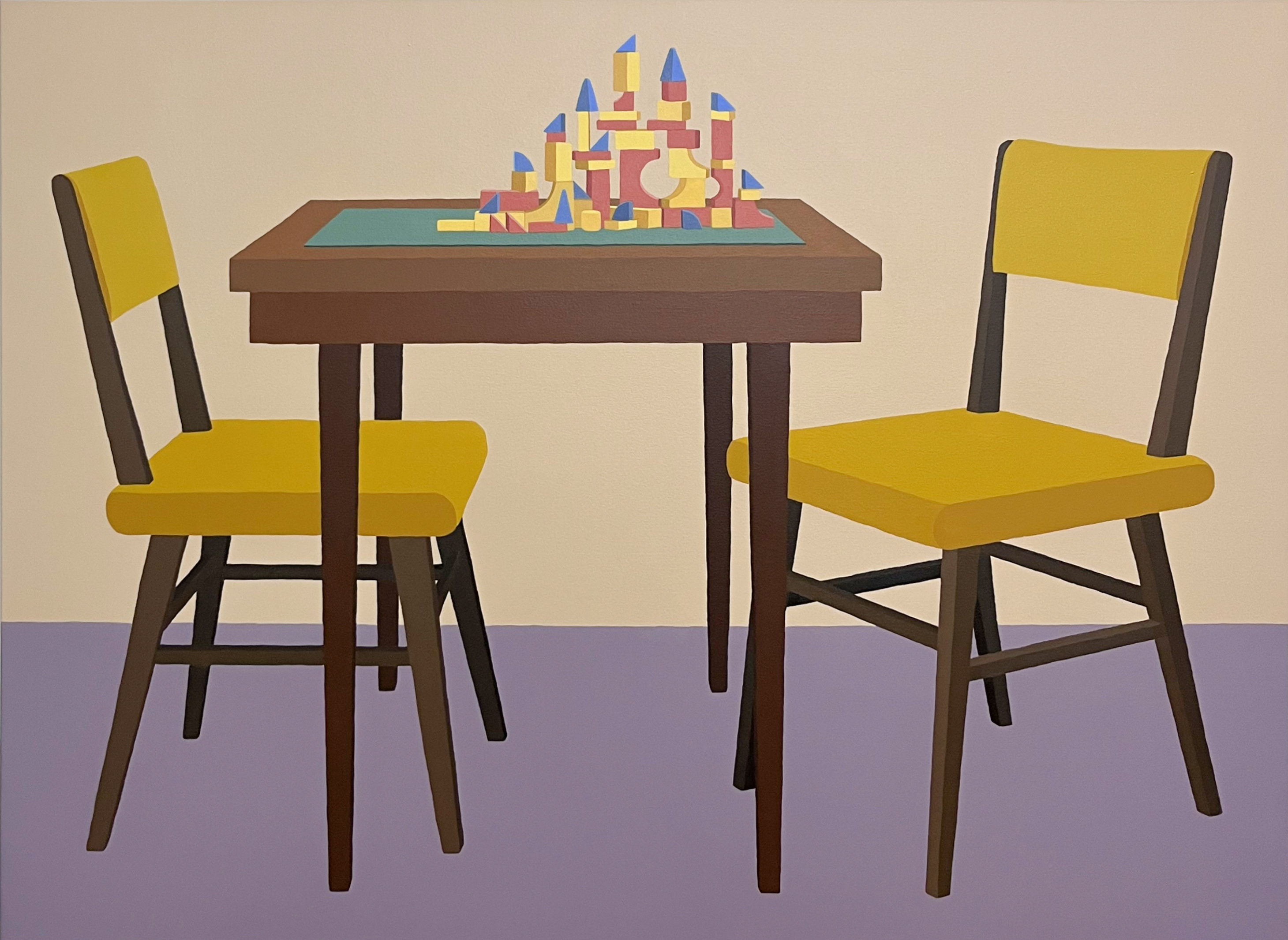ZSÓFIA SCHWÉGER: Balancing Act

Balancing Act is a series of carefully staged still lifes. The recurring objects in these paintings—a table, two chairs, and an old set of Anker building blocks—were originally purchased in 2022 as composition props for a different project. "Eventually we began using the furniture in the kitchen of my live/work studio, and in the autumn of 2023, in a bout of creative anxiety, the blocks resurfaced as well. For lack of a better idea, I began to play."
Zsofia Schweger's work is driven by her experience as a Hungarian living abroad first in the U.S. and the UK: she researches human relationships to spaces in general, as well as the notions of home and belonging in particular. Her paintings of interiors record, narrate and guide her search for a sense of belonging. She invites thought about stillness and movement, absence and presence, as well as intimacy and alienation. For Schweger, painting is an act of both observation and spatial construction. Home is not simply a place; rather, it is an experience built through repeated attempts at orientation. The canvas is a site where belonging is practised, rather than stated.
In these newest works, the earlier questions persist, but the focus has shifted to where daily life and artistic practice meet. A single scene recurs across most paintings: two chairs and a kitchen table that serves both as a site of shared meals and as a creative stage. The compositions centre around the tabletop, busy with building blocks. The elaborate structures are made possible by the innovative fabrication method of the nineteenth-century Anker blocks: they are made of a mixture of quartz sand, linseed oil, and red, yellow or blue colour pigments. Heavier than traditional wooden blocks, they are more stable. And yet, in Schweger's paintings, every structure seems to be on the verge of collapse.
In these dramatic pre-collapse moments, play gives way to the compulsion of repetition: the need to rebuild feels both urgent and important, even as it seems removed from the act of painting itself. Here, Schweger references Bruce Nauman's 1960s studio performances and his "idea that when you don't know what to do, then whatever it is that you are doing at the time becomes the work." Schweger's tabletop similarly becomes a space of productive procrastination. What first appears as pointless repetition reveals itself as an open-ended study of time and play as creative forces. The act of play, viewed as method, drives the new paintings. The Anker blocks become both subject and symbol. They are a metaphor for instability, echoing both the generative potential and pervasive uncertainty of repeating, rebuilding, restarting.
The Balancing Act series remains in close dialogue with Schweger's earlier works. Her longstanding interest in space and structure, centred on the concept of home, now finds a tangible form in the physical gesture of playing with building blocks. The desire to create order within space persists but the order here is precarious. Schweger references the subversive precision of Charles Sheeler's Doylestown paintings of domestic interiors, but in Schweger's works precision is always uncertain. She uses reductive paint application and flat blocks of colour, but the trace of the hand is preserved: colour blocks meet imperfectly, and lines that appear straight from afar reveal a slight tremor up close.
In her unpeopled interiors, Schweger further explores ideas of human presence through compositional decisions. The large-scale format, the use of one-point linear perspective where the table is positioned at eye level, and the nearly life-size representation of Anker blocks all serve to draw the viewer into a spatial relationship with the paintings. The aim is to encourage a durational viewing experience and therefore a sense of being present.
After all, the tension in these works is rooted in the absence of painted figures. The chairs appear to await someone, and the Anker-block arrangements carry the imprint of human touch and concentration. In this interplay of presence and absence, Schweger found inspiration in the restrained intimacy of Giorgio Morandi's still lifes of everyday objects. Her attempt at a dialogue with Morandi is most palpable in the smallest Balancing Act paintings, which isolate the Anker blocks. As with Morandi, the point is less the objects than the practice of arranging.
The infinite geometric variability of Anker-block arrangements, emphasised especially in the small paintings, offers a sense of control and potentially invites a formalist reading. Yet every structure hovers at the edge of collapse, and the tension is as psychological as it is formal. The repeated act of building and rebuilding (and painting and repainting) mirrors the vigilance of daily life amid persistent uncertainty. In this unsettled condition, attention becomes labour: the work of holding things together, of holding it together.


